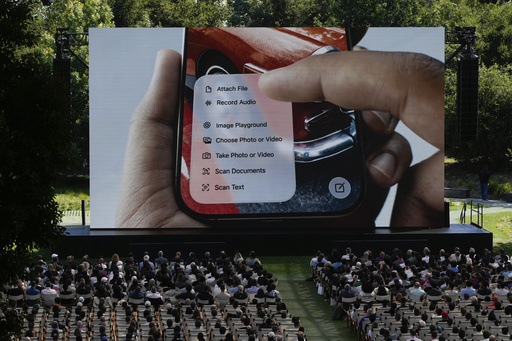At its annual developers’ conference on Monday, held at their Cupertino headquarters, Apple aimed to regain momentum in the competitive artificial intelligence sector. The event, attended by thousands of developers from approximately 60 countries, was notably more reserved than the gatherings of the past couple of years, which had been filled with great anticipation.
During this year’s conference, Apple showcased plans for AI enhancements meant to streamline user experiences and craft more intuitive products. An early preview of the most significant redesign of its iPhone software in a decade was also unveiled. However, Apple refrained from grand promises about breakthroughs, leading some analysts to label the event less than impressive.
In 2023, Apple’s mixed-reality headset barely gained traction. Last year’s announcement of AI advancements, including a more advanced Siri, remains unrealized. Craig Federighi, a key figure in Apple’s software division, acknowledged the extended timeline needed to enhance Siri’s AI capabilities, with no definitive release date given, though it is anticipated by next year at the earliest.
The silence regarding Siri was striking, according to industry analysts. The delay in Sirius development raises questions about Apple’s capability to deliver an interactive AI experience. As the timeline narrows, expectations for Siri continue to loom large.
Despite questions about its innovative vigour, Apple introduced “Liquid Glass” for a fresh software design, along with a new video game hub and features like “Workout Buddy.” The strategy seemed focused on enhancing user experience and aligning its software with its cutting-edge computer chips to foster seamless transitions between Apple devices.
The revamped “Liquid Glass” design applies a transparent aesthetic across Apple’s platform lineup, providing icons with a more curved look and enhancing app display options. Francisco Jeronimo, an analyst, suggested Apple’s event focused on refining platforms for future developments rather than immediate innovations.
In line with an automotive trend of linking new models to the subsequent year, Apple rebranded its next operating system as iOS 26, deviating from its traditional naming pattern. This shift is scheduled alongside the next iPhone release in the fall.
Apple’s playful nod to Formula 1 racing in a conference opening video inadvertently mirrored its race to match AI developments. Despite releasing new AI features for iPhones last year, a more advanced Siri remains elusive, hindering Apple’s promotional efforts.
Competitors like Google and Samsung are rapidly advancing in AI integration within their products, while developments like ChatGPT collaborating with former Apple design chief Jony Ive signal emerging competition for Apple.
Furthermore, Apple faces significant regulatory and trade challenges. Proposed countermeasures against Google’s alleged search monopoly could affect lucrative agreements between the companies, while new judicial decisions impact Apple’s in-app transaction revenues. Simultaneously, the ongoing trade tensions with China, exacerbated under current U.S. administration policies, add layers of complexity.
These combined pressures have adversely impacted Apple’s market standing, with its stock value dropping significantly. Once the globe’s most valuable entity, Apple has fallen behind Microsoft and Nvidia.
Apple’s stock fell by over 1% on Monday, indicating a lukewarm reaction from investors to its recent announcements.



